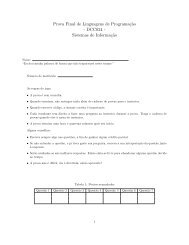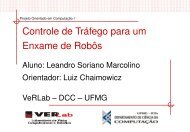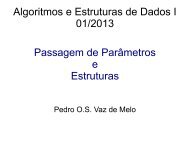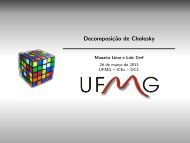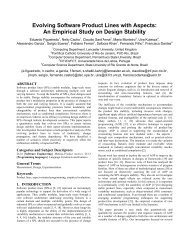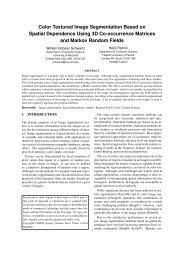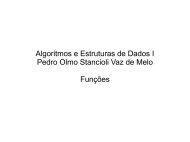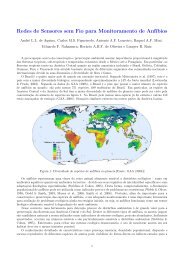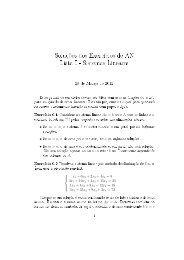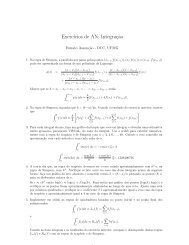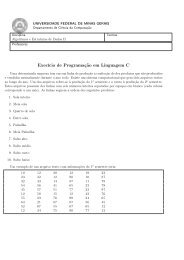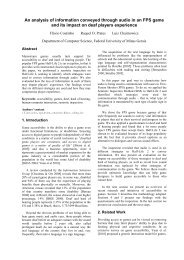Simple and Space-Efficient Minimal Perfect Hash Functions * - Liacs
Simple and Space-Efficient Minimal Perfect Hash Functions * - Liacs
Simple and Space-Efficient Minimal Perfect Hash Functions * - Liacs
Create successful ePaper yourself
Turn your PDF publications into a flip-book with our unique Google optimized e-Paper software.
log(3)(1.23 + ε)n bits to be stored, which is approximately 1.95n bits for ε = 0.<br />
For this we must replace the special value r = 3 to 0.<br />
6 The Full R<strong>and</strong>omness Assumption<br />
The full r<strong>and</strong>omness assumption is not feasible because each hash function hi :<br />
U → [i m m<br />
m<br />
r , (i + 1) r − 1] for 0 ≤ i < r would require at least n log r bits to be<br />
stored, exceeding the space for the PHFs. From a theoretical perspective, the<br />
full r<strong>and</strong>omness assumption is not too harmful, as we can use the “split <strong>and</strong><br />
share” approach of Dietzfelbinger <strong>and</strong> Weidling [8]. The additional space usage<br />
is then a lower order term of O(n1−Ω(1) ). Specifically, the algorithm would split<br />
S into O(n1−δ ) buckets of size nδ , where δ < 1/3, say, <strong>and</strong> create a perfect<br />
hash function for each bucket using a pool of O(r) simple hash functions of size<br />
O(n2δ ), where each acts like truly r<strong>and</strong>om functions on each bucket, with high<br />
probability. From this pool, we can find r suitable functions for each bucket, with<br />
high probability. Putting everything together to form a perfect hash function for<br />
S can be done using an offset table of size O(n1−δ ).<br />
Implementation. In practice, limited r<strong>and</strong>omness is often as good as total<br />
r<strong>and</strong>omness [21]. For our experiments we choose hi from a family H of universal<br />
hash functions proposed by Alon, Dietzfelbinger, Miltersen <strong>and</strong> Petrank [1], <strong>and</strong><br />
we verify experimentally that the schemes behave well (see Section 7). We use a<br />
function h ′ from H so that the functions hi are computed in parallel. For that,<br />
we impose some upper bound L on the lengths of the keys in S. The function<br />
h ′ has the following form: h ′ (x) = Ax, where x ∈ S ⊆ {0, 1} L <strong>and</strong> A is a γ × L<br />
matrix in which the elements are r<strong>and</strong>omly chosen from {0, 1}. The output is a<br />
bit string of an a priori defined size γ. Each hash function hi is computed by<br />
m ) + i( ), where a = βi, b = a + β − 1 <strong>and</strong> β is the<br />
hi(x) = h ′ (x)[a, b] mod ( m<br />
r r<br />
number of bits used from h ′ for computing each hi. In [2] it is shown a tabulation<br />
idea that can be used to efficiently implement h ′ <strong>and</strong>, consequently, the functions<br />
hi. The storage space required for the hash functions hi corresponds to the one<br />
required for h ′ , which is γ × L bits.<br />
7 Experimental Results<br />
In this section we evaluate the performance of our algorithms. We compare them<br />
with the main practical minimal perfect hashing algorithms we found in the<br />
literature. They are: Botelho, Kohayakawa <strong>and</strong> Ziviani [4] (referred to as BKZ),<br />
Fox, Chen <strong>and</strong> Heath [9] (referred to as FCH), Majewski, Wormald, Havas <strong>and</strong><br />
Czech [16] (referred to as MWHC), <strong>and</strong> Pagh [18] (referred to as PAGH). For the<br />
MWHC algorithm we used the version based on 3-graphs. We did not consider<br />
the one that uses 2-graphs because it is shown in [4] that the BKZ algorithm<br />
outperforms it. We used the linear hash functions presented in Section 6 for all<br />
the algorithms.



